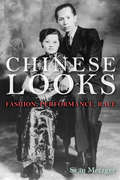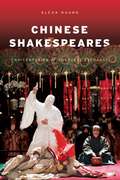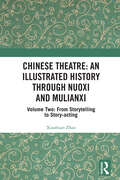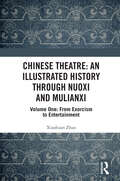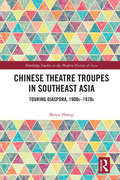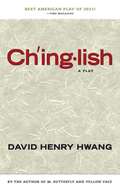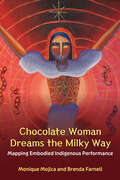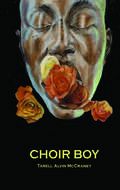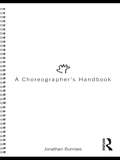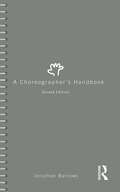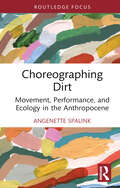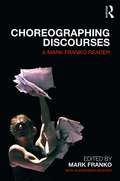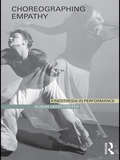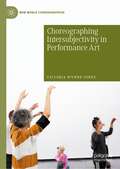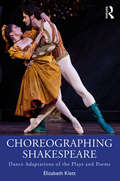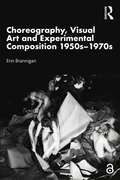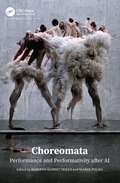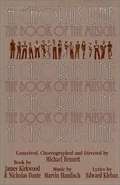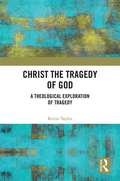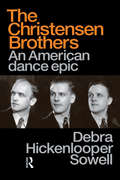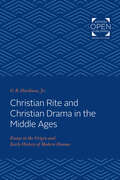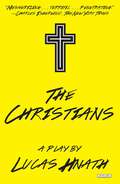- Table View
- List View
Chinese Looks
by Sean MetzgerFrom yellow-face performance in the 19th century to Jackie Chan in the 21st, Chinese Looks examines articles of clothing and modes of adornment as a window on how American views of China have changed in the past 150 years. Sean Metzger provides a cultural history of three iconic objects in theatrical and cinematic performance: the queue, or man's hair braid; the woman's suit known as the qipao; and the Mao suit. Each object emerges at a pivotal moment in US-China relations, indexing shifts in the balance of power between the two nations. Metzger shows how aesthetics, gender, politics, economics, and race are interwoven and argues that close examination of particular forms of dress can help us think anew about gender and modernity.
Chinese Shakespeares: Two Centuries of Cultural Exchange (Global Chinese Culture)
by Alexa HuangFor close to two hundred years, the ideas of Shakespeare have inspired incredible work in the literature, fiction, theater, and cinema of China, Taiwan, and Hong Kong. From the novels of Lao She and Lin Shu to Lu Xun's search for a Chinese "Shakespeare," and from Feng Xiaogang's martial arts films to labor camp memoirs, Soviet-Chinese theater, Chinese opera in Europe, and silent film, Shakespeare has been put to work in unexpected places, yielding a rich trove of transnational imagery and paradoxical citations in popular and political culture. Chinese Shakespeares is the first book to concentrate on both Shakespearean performance and Shakespeare's appearance in Sinophone culture and their ambiguous relationship to the postcolonial question. Substantiated by case studies of major cultural events and texts from the first Opium War in 1839 to our times, Chinese Shakespeares theorizes competing visions of "China" and "Shakespeare" in the global cultural marketplace and challenges the logic of fidelity-based criticism and the myth of cultural exclusivity. In her critique of the locality and ideological investments of authenticity in nationalism, modernity, Marxism, and personal identities, Huang reveals the truly transformative power of Chinese Shakespeares.
Chinese Theatre: Volume Two: From Storytelling to Story-acting
by Xiaohuan ZhaoChinese Theatre: An Illustrated History Through Nuoxi and Mulianxi is the first book in any language entirely devoted to a historical inquiry into Chinese theatre through Nuoxi and Mulianxi, the two most representative and predominant forms of Chinese temple theatre. Volume Two is a continuation of the historical inquiry into Chinese theatre with focus shifted from Mulian storytelling to Mulian story-acting. Thus, this volume traces the historical trajectory of xiqu from Northern dramas to Southern dramas and from elite court theatre to mass regional theatre with pivotal forms and functions of Mulianxi examined, explicated and illustrated in association with the development of corresponding genres of xiqu. In so doing, every aspect of Mulianxi is considered not in the margins of xiqu but in and of itself. While this volume is primarily concerned with Mulianxi, references are also made to other forms of Chinese performing arts and temple theatre, Nuoxi in particular, as Mulianxi has been performed since the twelfth century as, or in company with, Nuoxi, to cleanse the community of evil spirits and epidemic diseases. This is an interdisciplinary book project that is aimed to help researchers and students of theatre history understand the ritual origins of Chinese theatre and the dynamic relationships among myth, ritual, religion and theatre.
Chinese Theatre: Volume One: From Exorcism to Entertainment
by Xioahuan ZhaoChinese Theatre: An Illustrated History Through Nuoxi and Mulianxi is the first book in any language entirely devoted to a historical inquiry into Chinese theatre through Nuoxi and Mulianxi, the two most representative and predominant forms of Chinese temple theatre. With a view to evaluating the role of temple theatre in the development of xiqu or traditional Chinese theatre and drama from myth to ritual to ritual drama to drama, Volume One provides a panoramic perspective that allows every aspect of Nuoxi to be considered, not in the margins of xiqu but in and of itself. Thus, this volume traces xiqu history from its shamanic roots in exorcism rituals of Nuo to various forms of ritual and theatrical performance presented at temple fairs, during community and calendrical festivals or for ceremonial functions over the course of imperial history, and into the twenty-first century, followed by an exploration of the scriptural origins and oral traditions of Mulianxi, with pivotal forms and functions of Nuoxi and Mulian storytelling, examined, explicated and illustrated in association with the development of corresponding genres of Chines performance literature and performing arts. This is an interdisciplinary book project that is aimed to help researchers and students of theatre history understand the ritual origins of Chinese theatre and the dynamic relationships among myth, ritual, religion, and theatre.
Chinese Theatre Troupes in Southeast Asia: Touring Diaspora, 1900s–1970s (Routledge Studies in the Modern History of Asia)
by Beiyu ZhangA detailed account of the cultural history of the Chinese diaspora, with a focus on the performers and audiences who were involved in the making of Chinese performing cultures in Southeast Asia. Focusing on five different kinds of theatre troupes from China and their respective travels in Singapore, Bangkok, Malaya and Hong Kong, Zhang examines their different travelling experiences and divergent cultural practices. She thus sheds light on how transnational mobility was embodied, practised and circumscribed in the course of troupes’ travelling, sojourning and interacting with diasporic communities. These troupes communicated diverse discourses and ideologies influenced by different social political movements in China, and these meanings were further altered by transmission. By unpacking multiple ways of performing Chineseness that was determined by changing time-space constructions, this volume provides valuable insight for scholars of the Chinese Diaspora, Transnational History and Performing Arts in Asia.
Chinglish
by David Henry Hwang"Marvelous . . . the conceit is elegantly of a piece, yet Hwang is able to keep turning it in on itself to reveal new ambiguities, absurdities, subversions and paradoxes."--Chicago Reader "Hwang's plays collectively chart the evolving definition of what it is to be an 'American.' . . . His art has illuminated and anticipated our ongoing national story with a sensibility unlike any other in the American theater."--Frank Rich Springing from the author's personal experiences in China over the past five years, Chinglish follows a Midwestern American businessman desperately seeking to score a lucrative contact for his family's firm as he travels to China only to discover how much he doesn't understand. Named for the unique and often comical third language that evolves from attempts to translate Chinese signs into English, Chinglish explores the challenges of doing business in a culture whose language--and ways of communicating--are worlds apart from our own. David Henry Hwang's "best new work since M. Butterfly, this shrewd, timely and razor-sharp comedy" (Chicago Tribune) received its Broadway premiere in fall 2011. David Henry Hwang is the author of the Tony Award-winning M. Butterfly, the Pulitzer Prize-finalist Yellow Face, Golden Child, FOB, Family Devotions, and the books for musicals Aida (as co-author), Flower Drum Song (2002 Broadway revival), and Tarzan, among other works.
Chocolate Woman Dreams the Milky Way: Mapping Embodied Indigenous Performance (Theater: Theory/Text/Performance)
by Monique Mojica Brenda FarnellThis volume documents the creation of Chocolate Woman Dreams the Milky Way, a play written and performed by Monique Mojica with collaborators from diverse disciplines. Inspired by the pictographic writing and mola textiles of the Guna, an indigenous people of Panama and Colombia, the book explores Mojica’s unique approach to the performance process. Her method activates an Indigenous theatrical process that privileges the body in contrast to Western theater’s privileging of the written text, and rethinks the role of land, body, and movement, as well as dramatic story-structure and performance style. Co-authored with anthropologist Brenda Farnell, the book challenges the divide between artist and scholar, and addresses the many levels of cultural, disciplinary, and linguistic translations required to achieve this. Placing the complex intellect inherent to Indigenous Knowledges at its center, the book engages Indigenous performance theory, and concepts that link body, land, and story, such as terra nullius/corpus nullius, mapping, pattern literacy, land literacy, and movement literacy. Enhanced by contributions from other artists and scholars, the book challenges Eurocentric ideologies about what counts as “performance” and what is required from an “audience,” as well as long-standing body-mind dualisms.
Choir Boy
by Tarell Alvin Mccraney"An exhilarating, multi-layered new play."-The Guardian"Stirring and stylishly told . . . McCraney's crispest and most confident work."-Daily News"Greatly affecting. . . . It takes a brave writer to set his language against the plaintive beauty of the hymns and spirituals . . . but McCraney's speech holds its own, locating poetry even in casual vernacular and again demonstrating his gift for simile and metaphor."-The Village VoiceThe Charles R. Drew Prep School for Boys is dedicated to the creation of strong, ethical black men. Pharus wants nothing more than to take his rightful place as leader of the school's legendary gospel choir, but can he find his way inside the hallowed halls of this institution if he sings in his own key? Known for his unique brand of urban lyricism, Tarrell Alvin McCraney follows up his acclaimed trilogy The Brother/Sister Plays with this affecting portrait of a gay youth trying to find the courage to let the truth about himself be known. Set against the sorrowful sounds of hymns and spirituals, Choir Boy premiered at the Royal Court in London before receiving its Off-Broadway premiere in summer 2013 to critical and popular acclaim.Tarell Alvin McCraney is author of The Brother/Sister Plays: The Brothers Size, In the Red and Brown Water, and Marcus; Or the Secret of Sweet. Other works include Wig Out!, set in New York's drag clubs, and The Breach, which deals with the aftermath of Hurricane Katrina. His awards include the 2009 Steinberg Playwrights Award and the Paula Vogel Playwriting Award.
Choir Boy
by Tarell Alvin Mccraney"An exhilarating, multi-layered new play."-The Guardian"Stirring and stylishly told . . . McCraney's crispest and most confident work."-Daily News"Greatly affecting. . . . It takes a brave writer to set his language against the plaintive beauty of the hymns and spirituals . . . but McCraney's speech holds its own, locating poetry even in casual vernacular and again demonstrating his gift for simile and metaphor."-The Village VoiceThe Charles R. Drew Prep School for Boys is dedicated to the creation of strong, ethical black men. Pharus wants nothing more than to take his rightful place as leader of the school's legendary gospel choir, but can he find his way inside the hallowed halls of this institution if he sings in his own key? Known for his unique brand of urban lyricism, Tarrell Alvin McCraney follows up his acclaimed trilogy The Brother/Sister Plays with this affecting portrait of a gay youth trying to find the courage to let the truth about himself be known. Set against the sorrowful sounds of hymns and spirituals, Choir Boy premiered at the Royal Court in London before receiving its Off-Broadway premiere in summer 2013 to critical and popular acclaim.Tarell Alvin McCraney is author of The Brother/Sister Plays: The Brothers Size, In the Red and Brown Water, and Marcus; Or the Secret of Sweet. Other works include Wig Out!, set in New York's drag clubs, and The Breach, which deals with the aftermath of Hurricane Katrina. His awards include the 2009 Steinberg Playwrights Award and the Paula Vogel Playwriting Award.
Choral Mediations in Greek Tragedy
by Renaud Gagné Marianne Govers HopmanThis volume explores how the choruses of Ancient Greek tragedy creatively combined media and discourses to generate their own specific forms of meaning. The contributors analyse choruses as fictional, religious and civic performers; as combinations of text, song and dance; and as objects of reflection in themselves, in relation and contrast to the choruses of comedy and melic poetry. Drawing on earlier analyses of the social context of Greek drama, the non-textual dimensions of tragedy, and the relations between dramatic and melic choruses, the chapters explore the uses of various analytic tools in allowing us better to capture the specificity of the tragic chorus. Special attention is given to the physicality of choral dancing, musical interactions between choruses and actors, the trajectories of reception, and the treatment of time and space in the odes.
A Choreographer's Handbook
by Jonathan BurrowsOn choreography: "Choreography is a negotiation with the patterns your body is thinking" On rules: "Try breaking the rules on a need to break the rules basis" A Choreographer’s Handbook invites the reader to investigate how and why to make a dance performance. In an inspiring and unusually empowering sequence of stories, ideas and paradoxes, internationally renowned dancer, choreographer and teacher Jonathan Burrows explains how it’s possible to navigate a course through this complex process. It is a stunning reflection on a personal practice and professional journey, and draws upon five years’ of workshop discussions, led by Burrows. Burrows’ open and honest prose gives the reader access to a range of exercises, meditations, principles and ideas on choreography that allow artists and dance-makers to find their own aesthetic process. It is a book for anyone interested in making performance, at whatever level and in whichever style.
A Choreographer's Handbook
by Jonathan BurrowsOn choreography: ‘Choreography is a negotiation with the patterns your body is thinking.’On rules: ‘Try breaking the rules on a need to break the rules basis.’The updated and revised edition of 'A Choreographer’s Handbook' invites the reader to investigate how and why to make a dance performance. In an inspiring and unusually empowering sequence of stories, questions, ideas and paradoxes, internationally renowned choreographer Jonathan Burrows explains how it’s possible to navigate a course through this complex process.It is a stunning reflection on a personal practice and professional journey, and draws upon many years of workshop discussions, led by Burrows.Burrows’ open and honest prose gives the reader access to a range of principles, exercises, meditations and ideas on choreography that allow artists and dance-makers to find their own aesthetic process.It is a book for anyone interested in making performance, at whatever level and in whichever style.
Choreographing Dirt: Movement, Performance, and Ecology in the Anthropocene (Routledge Studies in Theatre, Ecology, and Performance)
by Angenette SpalinkThis book is an innovative study that places performance and dance studies in conversation with ecology by exploring the significance of dirt in performance. Focusing on a range of 20th- and 21st-century performances that include modern dance, dance-theatre, Butoh, and everyday life, this book demonstrates how the choreography of dirt makes biological, geographical, and cultural meaning, what the author terms "biogeocultography". Whether it’s the Foundling Father digging into the earth’s strata in Suzan-Lori Park’s The America Play (1994), peat hurling through the air in Pina Bausch’s The Rite of Spring (1975), dancers frantically shovelling out fistfuls of dirt in Eveoke Dance Theatre’s Las Mariposas (2010), or Butoh performers dancing with fungi in Iván-Daniel Espinosa’s Messengers Divinos (2018), each example shows how the incorporation of dirt can reveal micro-level interactions between species – like the interplay between microscopic skin bacteria and soil protozoa – and macro-level interactions – like the transformation of peat to a greenhouse gas. By demonstrating the stakes of moving dirt, this book posits that performance can operate as a space to grapple with the multifaceted ecological dilemmas of the Anthropocene. This book will be of broad interest to both practitioners and researchers in theatre, performance studies, dance, ecocriticism, and the environmental humanities.
Choreographing Discourses: A Mark Franko Reader
by Mark FrankoChoreographing Discourses brings together essays originally published by Mark Franko between 1996 and the contemporary moment. Assembling these essays from international, sometimes untranslated sources and curating their relationship to a rapidly changing field, this Reader offers an important resource in the dynamic scholarly fields of Dance and Performance Studies. What makes this volume especially appropriate for undergraduate and graduate teaching is its critical focus on twentieth- and twenty-first-century dance artists and choreographers – among these, Oskar Schlemmer, Merce Cunningham, Kazuo Ohno, William Forsythe, Bill T. Jones, and Pina Bausch, some of the most high-profile European, American, and Japanese artists of the past century. The volume’s constellation of topics delves into controversies that are essential turning points in the field (notably, Still/Here and Paris is Burning), which illuminate the spine of the field while interlinking dance scholarship with performance theory, film, visual, and public art. The volume contains the first critical assessments of Franko’s contribution to the field by André Lepecki and Gay Morris, and an interview incorporating a biographical dimension to the development of Franko’s work and its relation to his dance and choreography. Ultimately, this Reader encourages a wide scope of conversation and engagement, opening up core questions in ethics, embodiment, and performativity.
Choreographing Empathy: Kinesthesia in Performance
by Susan Foster"This is an urgently needed book � as the question of choreographing behavior enters into realms outside of the aesthetic domains of theatrical dance, Susan Foster writes a thoroughly compelling argument." � Andr�epecki, New York University"May well prove to be one of Susan Foster�s most important works." � Ramsay Burt, De Montford University, UKWh
Choreographing Intersubjectivity in Performance Art (New World Choreographies)
by Victoria Wynne-JonesThis book offers new ways of thinking about dance-related artworks that have taken place in galleries, museums and biennales over the past two decades as part of the choreographic turn. It focuses on the concept of intersubjectivity and theorises about what happens when subjects meet within a performance artwork. The resulting relations are crucial to instances of performance art in which embodied subjects engage as spectators, participants and performers in orchestrated art events. Choreographing Intersubjectivity in Performance Art deploys a multi-disciplinary approach across dance choreography and evolving manifestations of performance art. An innovative, overarching concept of choreography sustains the idea that intersubjectivity evolves through places, spaces, performance and spectatorship. Drawing upon international examples, the book introduces readers to performance art from the South Pacific and the complexities of de-colonising choreography. Artists Tino Sehgal, Xavier Le Roy, Jordan Wolfson, Alicia Frankovich and Shigeyuki Kihara are discussed.
Choreographing Shakespeare: Dance Adaptations of the Plays and Poems
by Elizabeth KlettChoreographing Shakespeare presents a hitherto unexplored history of the choreographers and performers who have created dance adaptations of Shakespeare. This book investigates forty dance works in genres such as ballet, modern dance, and hip-hop, produced between 1940 and 2016 by choreographers in Britain, America, and Europe, all of which use Shakespeare’s plays and Sonnets as their source material. By combining scholarly analysis of these productions with practice-based conversations from six contemporary choreographers, Klett offers both breadth of coverage and in-depth analysis of how Shakespeare’s poetic language is translated into the usually wordless medium of dance, and shows exactly how these dance adaptations move beyond the Shakespearean texts to engage with musical and choreographic influences. Ideal for students of Shakespeare and Dance Studies, Choreographing Shakespeare explores how dance adaptations strive to design legible and intelligible stories, while ultimately celebrating the beauty of pure movement.
Choreography, Visual Art and Experimental Composition 1950s–1970s
by Erin BranniganThis book traces the history of engagements between dance and the visual arts in the mid-twentieth century and provides a backdrop for the emerging field of contemporary, intermedial art practice. Exploring the disciplinary identity of dance in dialogue with the visual arts, this book unpacks how compositional methods that were dance-based informed visual art contexts. The book provokes fresh consideration of the entangled relationship between, and historiographic significance of, visual arts and dance by exploring movements in history that dance has been traditionally mapped to (Neo-Avant Garde, Neo-Dada, Conceptual art, Postmodernism, and Performance Art) and the specific practices and innovations from key people in the field (like John Cage, Anna Halprin, and Robert Rauschenberg). This book also employs a series of historical and critical case studies which show how compositional approaches from dance—breath, weight, tone, energy—informed the emergence of the intermedial. Ultimately this book shows how dance and choreography have played an important role in shaping visual arts culture and enables the re-imagination of current art practices through the use of choreographic tools. This unique and timely offering is important reading for those studying and researching in visual and fine arts, performance history and theory, dance practice and dance studies, as well as those working within the fields of dance and visual art.
Choreomata: Performance and Performativity after AI
by Roberto Alonso TrilloIs artificial intelligence (AI) becoming more and more expressive, or is human thought adopting more and more structures from computation? What does it mean to perform oneself through AI, or to construct one’s subjectivity through AI? How does AI continue to complicate what it means to have a body? Has the golden age of AI, especially with regards to creative applications, already ended? Choreomata: Performance and Performativity after AI is a book about performance and performativity, but more specifically, it is a book about the performance of artificiality and the performance of intelligence. Both humans and human-designed computational forces are thoroughly engaged in an entangled, mutual performance of AI. Choreomata spins up a latticework of interdisciplinary thought, pairing theoretical inquiry from philosophy, information theory, and computer science with practical case studies from visual art, dance, music, and social theory. Through cross-disciplinary proportions and a diverse roster of contributors, this book contains insights for computer scientists, social scientists, industry professionals, artists, and beyond.
A Chorus Line
by Michael Bennett James Kirkwood Nicholas DanteIt is hard to believe that over 25 years have passed since A Chorus Line first electrified a New York audience. The memories of the show's birth in 1975, not to mention those of its 15-year-life and poignant death, remain incandescent - and not just because nothing so exciting has happened to the American musical since. For a generation of theater people and theatergoers, A Chorus Line was and is the touchstone that defines the glittering promise, more often realized in legend than in reality, of the Broadway way. This impressive book contains the complete book and lyrics of one of the longest running shows in Broadway history with a preface by Samuel Freedman, an introduction by Frank Rich and lots of photos from the stage production.
Christ the Tragedy of God: A Theological Exploration of Tragedy
by Kevin TaylorTragedy is a genre for exploring loss and suffering, and this book traces the vital areas where tragedy has shaped and been a resource for Christian theology. There is a history to the relationship of theology and tragedy; tragic literature has explored areas of theological interest, and is present in the Bible and ongoing theological concerns. Christian theology has a long history of using what is at hand, and the genre of tragedy is no different. What are the merits and challenges of placing the central narrative of the passion, death and resurrection of Christ in tragic terms? This study examines important and shared concerns of theology and tragedy: sacrifice and war, rationality and order, historical contingency, blindness, guilt, and self-awareness. Theologians such as Reinhold Niebuhr, Hans Urs von Balthasar, Martin Luther King Jr., Simone Weil, and Boethius have explored tragedy as a theological resource. The historical relationship of theology and tragedy reveals that neither is monolithic, and both remain diverse and unstable areas of human thought. This fascinating book will be of keen interest to theologians, as well as scholars in the fields of literary studies and tragic theory.
Christensen Brothers: An American Dance Epic (Choreography and Dance Studies Series #Vol. 16)
by Debra Hickenlooper SowellFirst Published in 1998. Routledge is an imprint of Taylor & Francis, an informa company.
Christian Rite and Christian Drama in the Middle Ages: Essays in the Origin and Early History of Modern Drama
by O. B. Hardison Jr.Originally published in 1965. The European dramatic tradition rests on a group of religious dramas that appeared between the tenth and twelfth centuries. These dramas, of interest in themselves, are also important for the light they shed on three historical and critical problems: the relation of drama to ritual, the nature of dramatic form, and the development of representational techniques. Hardison's approach is based on the history of the Christian liturgy, on critical theories concerning the kinship of ritual and drama, and on close analysis of the chronology and content of the texts themselves. Beginning with liturgical commentaries of the ninth century, Hardison shows that writers of the period consciously interpreted the Mass and cycle of the church year in dramatic terms. By reconstructing the services themselves, he shows that they had an emphatic dramatic structure that reached its climax with the celebration of the Resurrection. Turning to the history of the Latin Resurrection play, Hardison suggests that the famous Quem quaeritis—the earliest of all medieval dramas—is best understood in relation to the baptismal rites of the Easter Vigil service. He sets forth a theory of the original form and function of the play based on the content of the earliest manuscripts as well as on vestigial ceremonial elements that survive in the later ones. Three texts from the eleventh and twelfth centuries are analyzed with emphasis on the change from ritual to representational modes. Hardison discusses why the form inherited from ritual remained unchanged, while the technique became increasingly representational. In studying the earliest vernacular dramas, Hardison examines the use of nonritual materials as sources of dramatic form, the influence of representational concepts of space and time on staging, and the development of nonceremonial techniques for composition of dialogue. The sudden appearance of these elements in vernacular drama suggests the existence of a hitherto unsuspected vernacular tradition considerably older than the earliest surviving vernacular plays.
The Christians: A Play
by Lucas HnathA big-little play about faith in America—and the trouble with changing your mind. Pastor Paul does not believe in Hell, and today, he's going to preach a sermon that finally says what he really believes. He thinks all the people in his church are going be happy to hear what he has to say. He's wrong.
